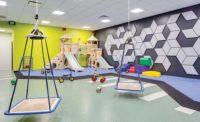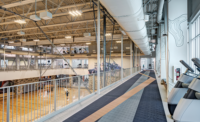The new 107,000-sq-ft J.L. Sorenson Recreation Center�Salt Lake County's largest and most energy-efficient recreation facility�celebrated its grand opening on March 18. Salt Lake City�s Layton Construction Co. Inc. was the general contractor for the project, and the facility was designed by EDA Architects.
The J.L. Sorenson Recreation Center, located in Herriman, Utah, features a competition-sized indoor swimming pool with eight lanes; an indoor leisure pool with slides, a lazy river and water play equipment; an indoor running and walking track; a 16,000-sq-ft double gymnasium; six competition racquetball courts; exercise and fitness equipment; a dance and aerobics studio; multi-use rooms; and a drop-in daycare area.
Layton started construction on the facility in June 2009 and spent almost two months getting the site ready before footings and foundation were put in place. The completed facility includes 8,800 cu yd of concrete, 400 tons of steel and 40,000 sq ft of copper sheets. Copper panels were an architectural theme integrated into the design to reflect the center’s surroundings and close proximity to the Kennecott Copper Mine.
“One of the things that we’re most proud of is our subcontractors and the many, many workmen that worked on this project,” said Chris Smith, Layton vice president of preconstruction, at the ribbon cutting. “We estimate that there are over a half million man-hours that went into building this facility.”
Layton and EDA worked closely to help the facility qualify for a LEED-Platinum certification from the U.S. Green Building Council. It will be the first LEED-Platinum-certified recreation center in Utah and will join an elite group as one of just six projects in the state to achieve a Platinum certification. The building was designed to use 40% less energy and 30% less water than a non-LEED-certified building of similar size.
Construction materials were chosen for their recycled content, lack of toxic materials and lack of emitting of harmful gases over time. Additionally, to meet a specific LEED requirement, all materials used in the facility are from no more than 500 miles away from the project site. Nearly 75% of the wood used in the facility is Forest Stewardship Council certified-sustainable. More than 95% of total waste was diverted from the landfill during construction.
Green features are prevalent throughout the completed facility. Glazing is largely present throughout the building to maximize daylight and views, with large expanses in the lobby, daycare area, exercise and dance rooms, racquetball courts, along the track and in the gymnasium. On sunny days, the gym can be fully lit by skylights that line the ceiling and determine the amount of artificial light needed, reducing the amount of electricity used on suitable weather days. Every area of the facility is equipped with motion light sensors that automatically turn lights off if a room is not in use.
The facility angles due south at the pool area to maximize solar heat gain, a design feature that was a key factor in the J.L. Sorenson Recreation Center qualifying for LEED-Platinum certification. Solar hot water panels on the building's roof assist in heating the pool, reducing the energy needed to warm almost 400,000 gal. of water. Ozone and UV aid in pool water sanitation and reduce the amount of chlorine required. Regenerative filters reduce water usage and water waste by 30%.
Additionally, water-conserving plumbing fixtures—including sensor faucets, low-flush/high-flush toilets and landscaping designed to conserve potable water with the use of secondary irrigation—will save more than 1 million gal. of water each year compared to a building that just meets current code requirements.
Completing such a large facility with so many specific requirements required a strong team effort.
"For us, we do many of these ribbon cuttings, groundbreakings and different events, [and] it’s time for us to recognize the men and women that worked on this project,” Smith said. “When you do a project such as this, it’s a team that comes together to do what seems like almost the impossible—we make it look routine.”
Article toolbar






Post a comment to this article
Report Abusive Comment